
S.S.
America

With Dr.
Reuben Goossens
Maritime
Historian & Author
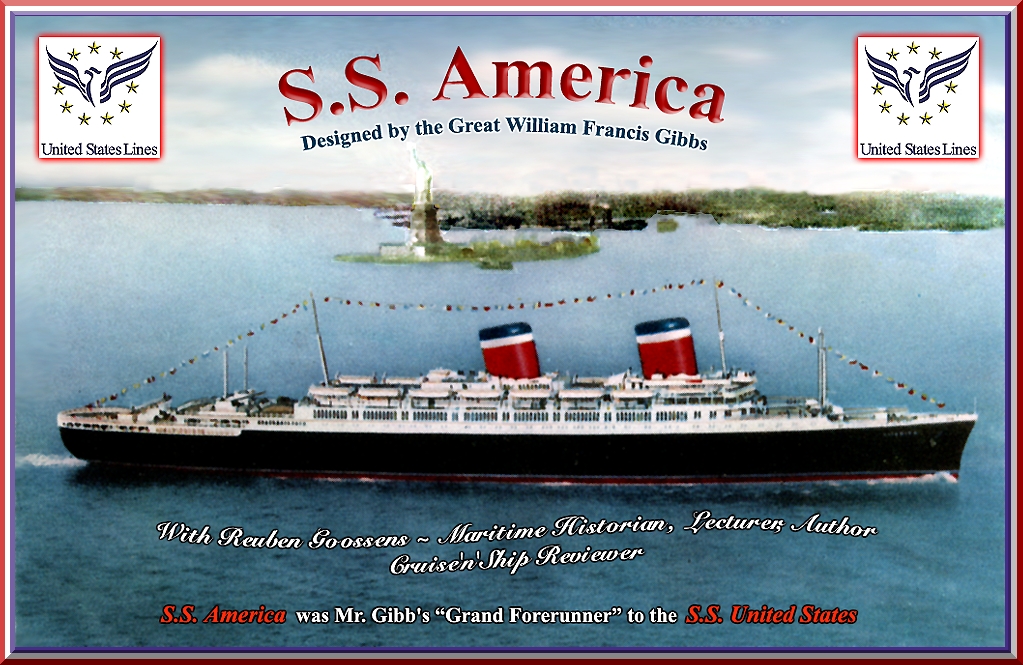
A
short Introduction:
For
me personally the “S.S. America” story is quite unique,
as this truly great ship was designed the one of the great in
naval/maritime design William Francis Gibbs of “Gibbs &
Cox” of New York. And later in her career I just
happened to manage her and another of Gibbs great masterpieces,
as he also was the designer of those great Matson Liners, such as
the Lurline and Monterey, etc, but all that will
come later in this very special multi faceted feature!
I
am in such awe of the late great William F. Gibbs that I have and
image of his bust proudly hanging in my gallery, and we should
also remember that he was also the designer of the greatest of
all American liners the S.S. United States, a ship that remained
with us until her tragic demise in 2025, when she was towed to
Mobile to be sunk to become “World’s Largest
Artificial Reef”. ssMaritime, together with my Save the
Classic Liner Campaign fully supported being restored, etc, but
that is now just a very sad dream that will never happen!
However,
my WebPages on her covers her forerunner, the wonderful S.S.
America which from her very conception in the mid 1930s to her
sale to Chandris Lines in 1964. Thus you will note the relevant
are links below. In addition you will also find a Photo Page
showing so much more of her interiors, and another Page with a
complete Deck Plan of the S.S. America as built, revealing the
ship with her original Cabin Class, Tourist and Third
Class! In addition you will discover that you are able to
click on each deck in order to enlarge it (opens on a separate
page) providing a greatly improved view. Thus, I believe that is
feature will have much for all classic ship lovers, but
especially those who love and admire this amazingly great Liner,
the S.S. America!
Enjoy!
Dr.
Reuben Goossens.
Maritime
Historian, Author & Lecturer and Ship Reviewer.
Working
for almost 63 years in the Passenger Shipping Industry,
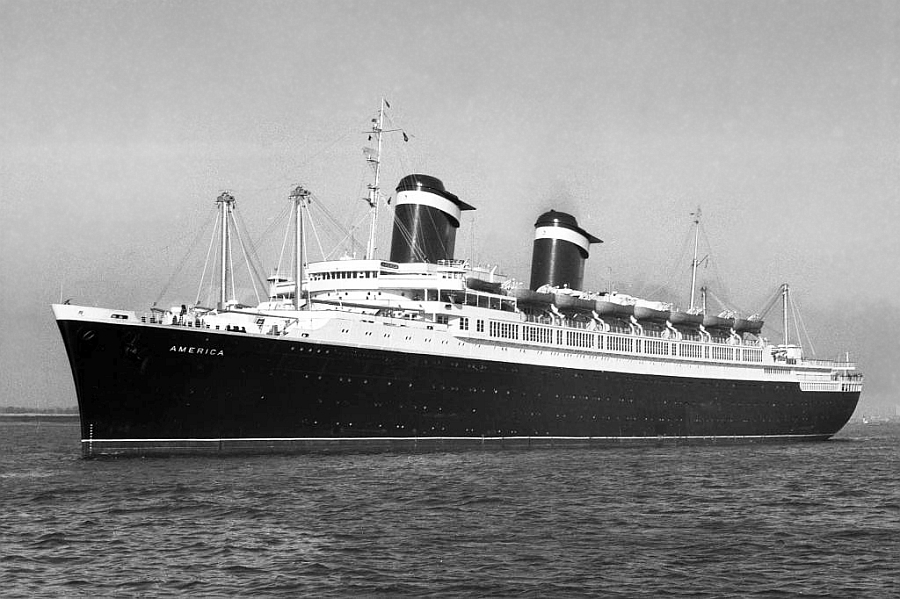
Here
we see a delightful company photograph of the S.S. America
looking so beautiful and graceful!
PLEASE
NOTE:
Photographs:
Many of the images on this page are from the author’s
private collection, having obtained them when he managed
the GSA of Chandris Lines, who operated the ex S.S.
America, then the S.S. Australis. These photographs came
from the agencies files and have been retained by myself to this
day! Those that are from other sources will as shown.
This
page will cover S.S. America’s glory years for she was
indeed the “Grand Forerunner” to the mighty S.S.
United States, yet the America was a very special and
certainly a magnificent Liner and the author in many ways
preferred her to
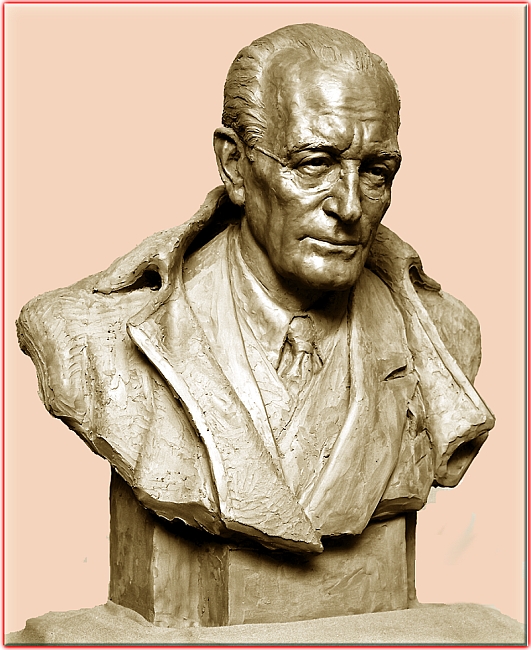
An
image of the bust of William Francis Gibb
The
actual bust is located at the “New-York Historical Society Museum”
The
Planning and Building of a Grand New Liner:
The
United States Lines together with the Shipping Board of America
commenced negotiating in 1933 for the building of a new Liner to
replace the S.S. Leviathan. Then on March 19, 1934 the United
States Lines and the Shipping Board signed a contract promising
to start construction within the next 6 months of a new ship,
although the ship remained unnamed. A month later it was
announced that the famed William Francis Gibb of, Gibbs and Cox
Naval Architects had been given the job of designing a new ship,
that would be the grand design for another, but the ultimate
American liner, thus this as yet unnamed ship would ultimately be
dubbed as the “Grand Forerunner” of the S.S. United
States!
We
need to understand that the S.S. Leviathan has been laid up from
1933 to 1937, as she had been losing huge amounts on the Atlantic
service. With this in mind, the agreement was stalled several
times, but thankfully it was finally set in concrete, so to say,
on March 18, 1935. On March 20, United States Lines President,
Mr. Basil Harris stated that the company proceed quickly with the
Gibbs & Cox plans for a $12 million, 50,000 gross ton, 24
knot super cabin liner.
However,
nothing more was heard until the announcement by the Shipping
Board on September 14, 1935 who finally instructed the United
States Lines to order the ship by December 16, or face a $1
million penalty. You may ask why, the sudden hurry? The Shipping
Board was well aware what was happening in Europe and
that it was more than likely that a major war could well
commence. Thus this new ship would be already prepared for such
possibilities, for the “United States Maritime
Commission” had subsidized her construction and certain
“defence features” had been included.
Tenders
were officially sought on October 10, however on November 12
there was just one applicant, being Newport News Ship building
& Dry Dock Company, and at a huge bid of US$15,890,000. Obviously,
considerable negotiations would go on with Newport News, and
there were even several other tenders coming in. But finally
a US$15,759,000 contract was signed on October 22,
1937. Thus, there was not a huge saving to be made considering
the total amount. On February 8, 1938, the ships lines and
dimensions had been fully approved and the go ahead given!
At
the yard, up to 5,000 tons of steel was arriving as her building
officially began on June 19, 1938, but her keel was to be laid in
late August, with the launching set for July 15, 1939, and
delivery for February 20, 1940.
The
new ship was designated “number 569” and her keel was
laid at 11:00 AM on August 22, 1938. The Maritime Commission
Chairman, Rear Admiral Emory S. Land, was the man to drive the
first rivet in, and for this, he received a shipyard official
“pay check” for six cents! This event was attended by
the United States Lines Vice President, Mr. A.J. McCarthy,
and Newport News President, Mr. Homer l Ferguson. By
September 19, they had used a good 1,915 Tons (4,222,935 pounds)
of steel and 112,000 rivets to complete her double bottom.
Naming
the New Ship:
Although
it was on December 4, 1938, the company’s President, Mr.
John Franklin, officially stated that their new Liner would be
named “America.” But, there had been an
astounding list of names she could have had, for all of the
following were considered: “Columbia, Martha Washington,
Constitution, Mayflower, Mount Vernon, Abraham Lincoln,
United States, New
Yorker, Chicago, Pittsburgh and Gettysburg.”
OK, these were all wonderful and good names, but I feel
that; S.S. America was just perfect for this superb Liner!
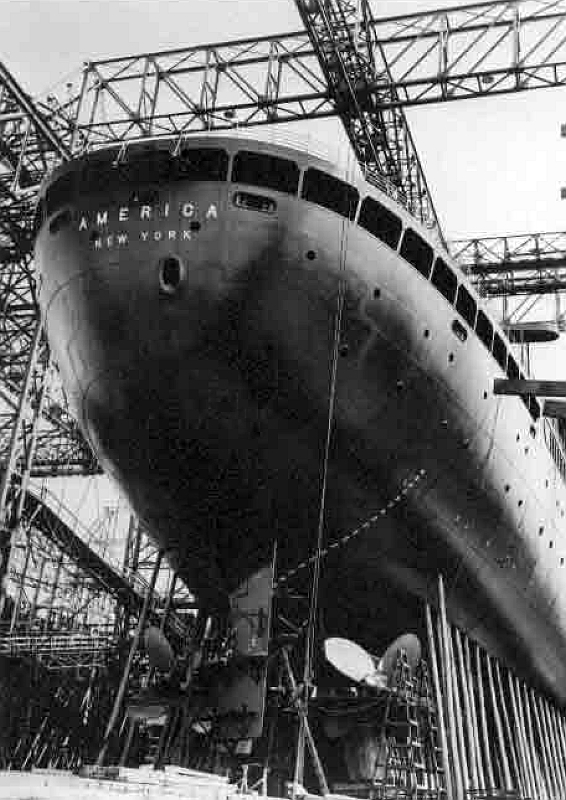
A
wonderful view her stern, rudder and her two - four bladed
propellers
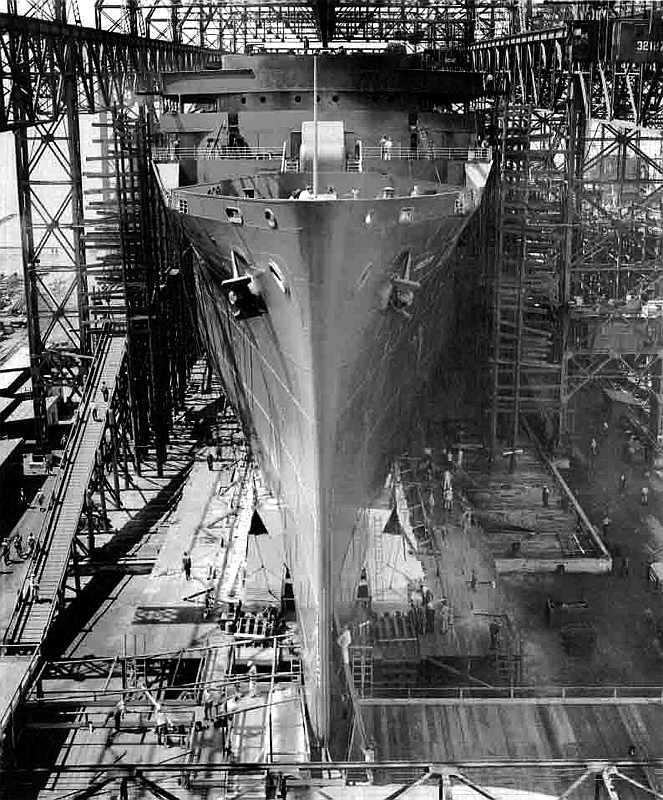
A
great view of her bow during her building at Newport News
Shipbuilding & Dry Dock
Launching
of the S.S. America:
With
the S.S. America having been completed ready to head for her
refitting berth, she was made ready for her official launching,
which would take place on August 31 1939. Having been
designed and built to weather any kind of North Atlantic
conditions the company was looking forward to see their new liner
head across to Southampton, but her entry into that market would
be slightly delayed for the day after she was launched, Hitler
invaded Poland, and suddenly the world found itself at war.
Thus, sending this new liner across the Atlantic was
suddenly no longer an option and a new solution was sought!
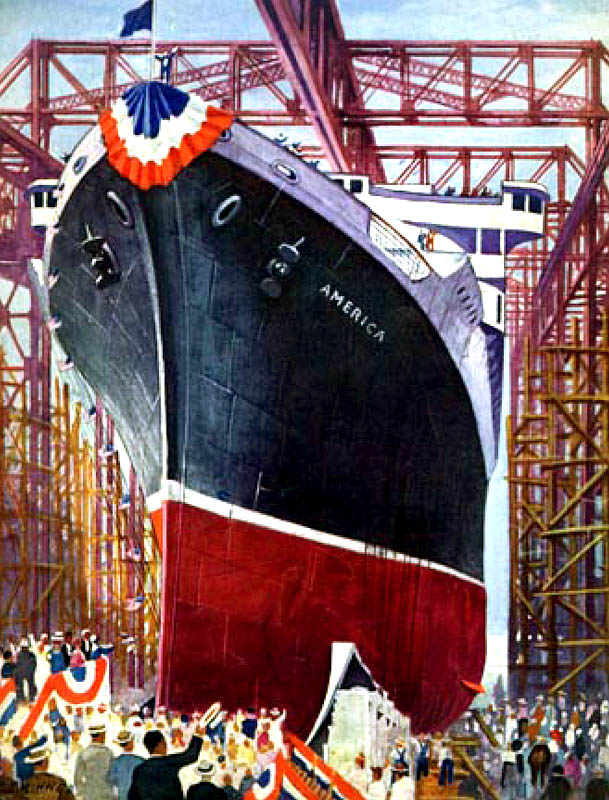
A
delightful impression the S.S. America seen at her joyful
launching
But,
the launching would go ahead, and it would be a major event!
Significantly, her gala launching on August 31, 1939 and official
“Christening” ay the hand of First Lady Mrs. Franklin D
Roosevelt that was witnessed by more than 30,000 people, was of
course overshadowed because what would happen the very next day.
However, the United States was already prepared for
such possibilities, for the “United States Maritime
Commission” had subsidized her construction and certain
“defence features” had been inconspicuously
incorporated into her design!
With
the America’s hull and superstructure having been just
primer painted. And having a launch weight of 16,870 tons, she
slipped majestically into the James River. And finally the
great S.S. America had been born! After the S.S. America was
launched she headed to her fit-out berth to be fitted and have
her seaworthiness tickets endorsed, etc.
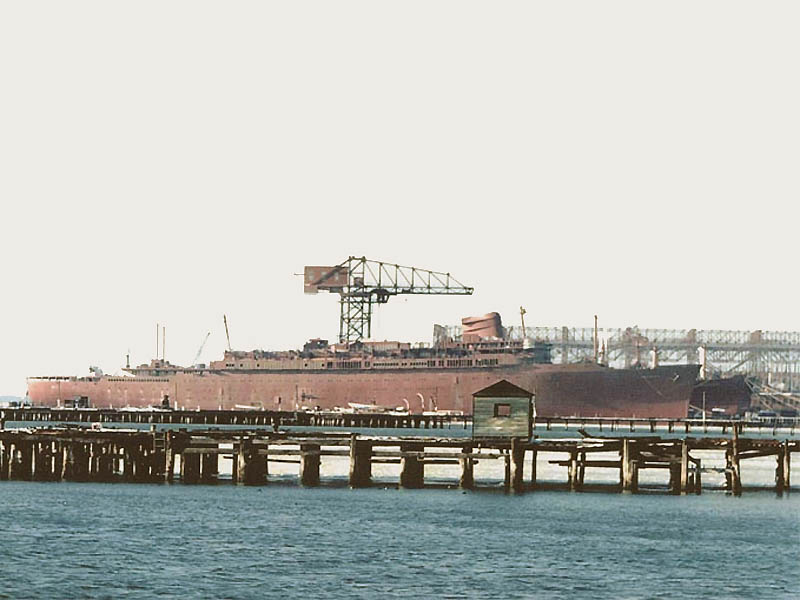
She
is seen here during her fitting out process and her forward
funnel has just been placed onboard
But
note the height, as it is rather low, more re this after her
official navy the “measured” mile trails!
S.S.
America finally completed departed form the yard at 0400 on June
4, 1940 under the command of Captain Joseph Kemp, onboard there
was some 500 yard workers for her official trials
of Virginia Capes. She returned 24 hours later with
“all’s well.” On the June 9 she headed to be dry
docked at the Boston Naval yard for painting of her underwater
hull.
Next
would be the standard Navy trials for the “measured”
mile course off Rockland Maine. These were held on June
13 and 14, followed by an 8 hour endurance run on which she
averaged 24.68 knots and under full revolutions delivering a
staggering 42,850 SHP reaching 25.3 knots.
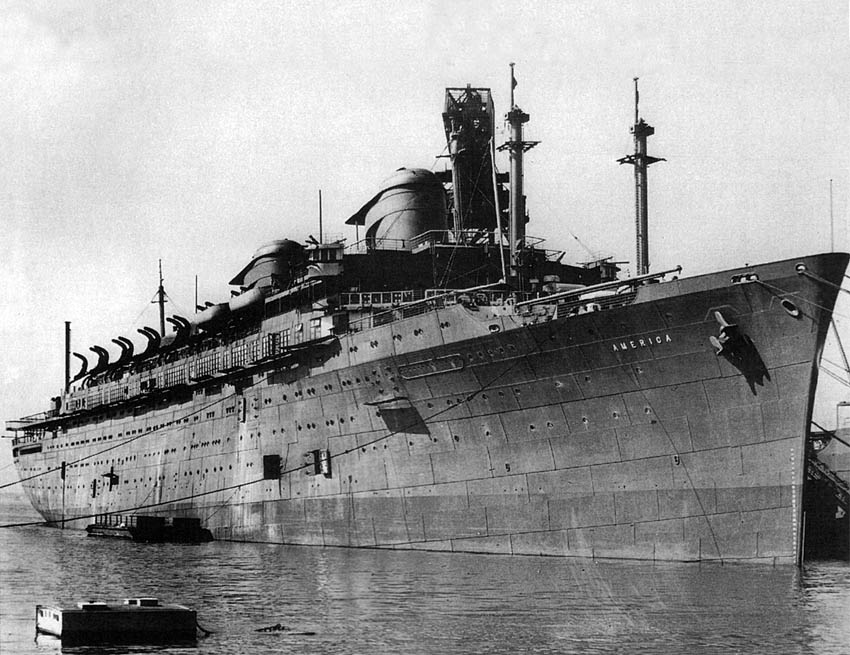
Here
we see the S.S. America at her fit-out berth on March 11, 1940
But
note her original rather low “San Pan” funnels,
which had to be heightened by a good 4.5m
The America was
returned to New Port News for some minor alterations and one
rather big mistake that being her low “San Pan funnels”
as these were a disappointment. Without any publicity whatsoever,
they were raised 4.57m - 15 feet that really enhanced her
appearance greatly. Another reason they had to be lifted was a
problem with smoke dispersion, as smut from her aft stack
covering her spacious aft decks. Whilst being painted for
completion, as a safe guard against possible submarine attack,
both sides of the S.S. America’s hull were emblazoned with
her name and country, as well as two large American flags at the
side, and against all normal war regulations, she would sail at
night with her hull fully illuminated!
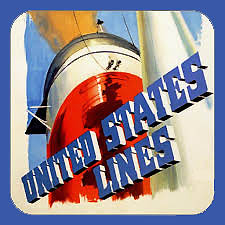
Here
we see a delightful label featuring her forward “San
Pan” funnel
Delivery
and the First Year of Operation:
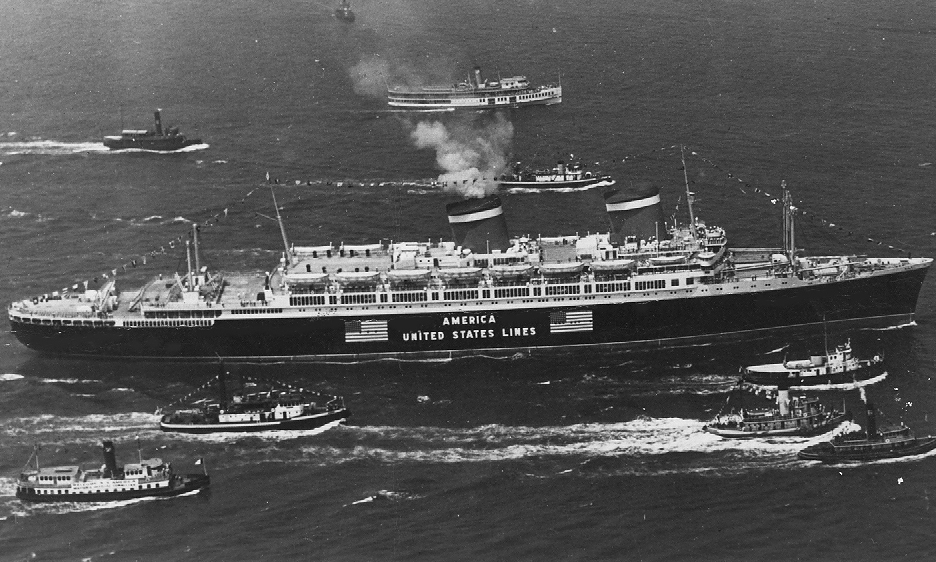
The
completed S.S. America arrives on July 2 in New York
City for the very first time and she is fully decked out!
The
S.S. America was officially delivered to the United States Lines
in New York on July 2, 1940. However, it would
take some time to prepare the ship for her new role, which would
be as a cruise ships around the West Indies (the Caribbean).
She had to be fully stored up with an ever higher grade of
services, being a cruise ship as well as food, and fine wines,
additional bands, and vocalists, etc, as well have all of her 618
officers and crew well and truly get used to the new ships and
settled in before she could be ready for her maiden voyage over a
month later.
However,
prior to her official maiden voyage, she did operate two
special “ten hour voyages to nowhere.” On August
5, she sailed at 10.00 AM with some 1,300 travel agents on board,
whilst the next day she sailed on another voyage with 1,500
freight agents.
Then
on August 10, 1940, the beautiful S.S. America finally departed
on her maiden voyage, being a cruise of course to
the Caribbean with some 775 passengers onboard, but
there was a crowd of over 3,000 people waving the ship off, such
was the occasion!
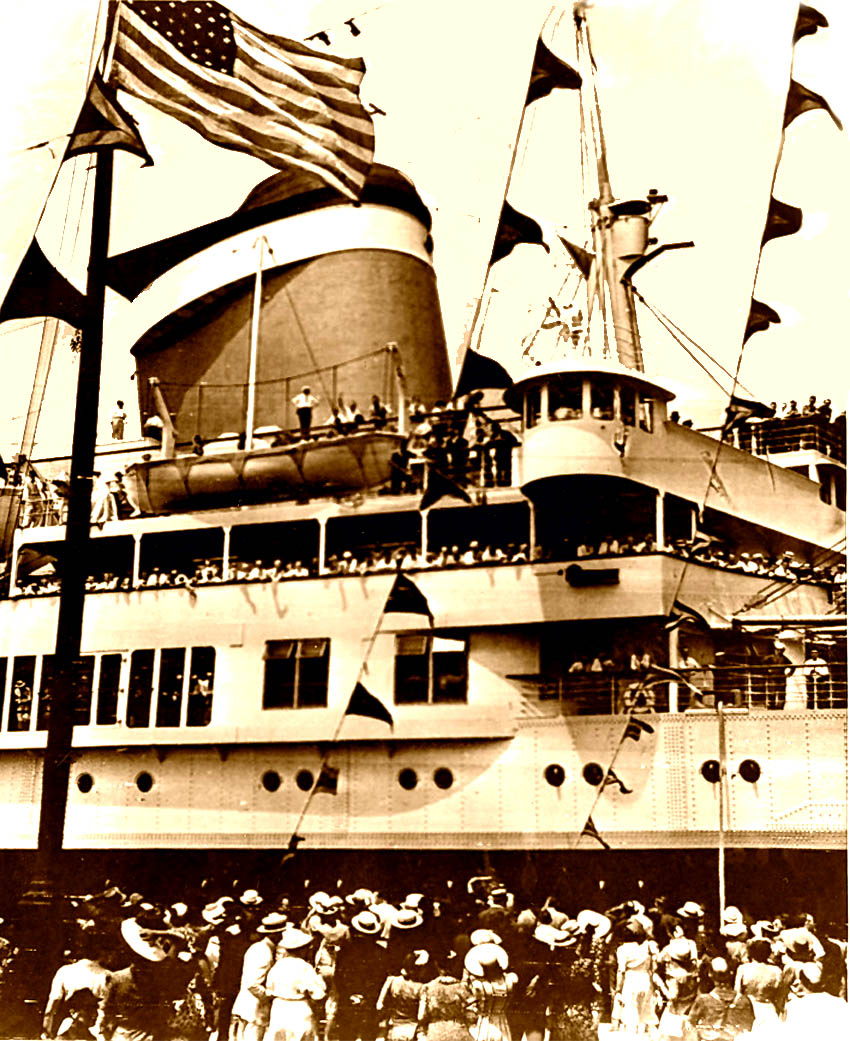
Great
excitement before the new liner sets sail on her Maiden Voyage
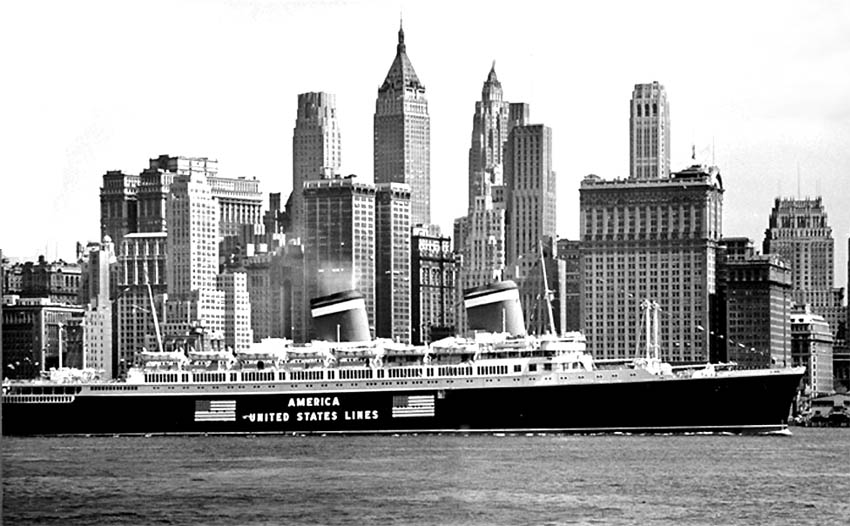
S.S.
America is seen departing on her maiden cruise to the West
Indies on August 10, 1940
S.S.
America returned on the 22nd August after her cruise to San
Juan. Although having been a successful and triumphant voyage,
these cruises would continue for just a few months. There was no
doubt everyone loved the ship and thus these cruises proved to be
popular and the ship in this short time gained many new friends,
for she was indeed a great American, both by name and in due
course she would become a fine International American Ambassador!
In
an amusing way, the Philadelphia newspaper on August
24, in part of their article stated; “Above all else you
are sailing the American Seas, under the American flag
on an American ship armed with nothing but the Stars and Stripes.”
The
Ship and her Interiors:
The
S.S. America certainly had a strikingly handsome appearance, and
looked a well balanced ship, with her black hull, red boot
topping with a fine white line separating it with the black hull,
and the gleaming white superstructure. Thus, she presented a
sleek and certainly dramatic appearance as her tall prow was
severely flared with that slight “clipper” rake, and
her nicely designed superstructure of four decks above the main
deck level, topped with a beautifully curved bridge as well as
her long glass enclosed promenade decks. Then topping her
beautifully-proportioned superstructure were those two now taller
oval shaped funnels, fitted with “San-Pan” tops.
Although, the forward funnel, was in reality a “dummy
funnel” which was the norm to create that well-balanced
profile, but it did house an emergency generator. The *“San
Pan” funnels were also fitted later to her new and larger
sister ship, the S.S. United States.
*”San
Pan” funnels became very much a future trademark of
United States Lines, and became a big feature on the S.S. United
States and other of the company’s ships.
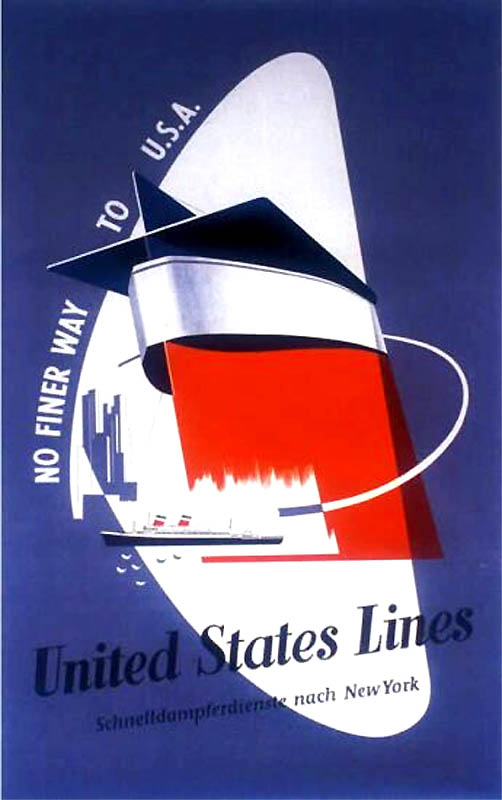
Here
we see a 1952 German poster, but it does shows off the “San
Pan” funnels rather well!
S.S.
America was in many ways a very unusual liner, the reason being
that she was the very first American liner to have her interiors
designed by women, who did away with those old and crusty very
traditional heavy and that overwrought décor in favour of a far
more friendly and modern, thus a more sophisticated design.
The America would incorporate the latest in design
using such materials as the finest ceramics and stainless steel,
as well as the latest in safety features. She was considered as
the most beautiful and elegant of any of the American ships, and
her passengers were provided with the last word in comfort,
cuisine and the very best in service.
Thus,
knowing the details as per above, which is not generally know, it
becomes understandable that the S.S. America’s interiors was
the ultimate in contemporary American design and décor, all
thanks to her interiors designers “Smyth, Urquart & Marckwald” of
New York, who decided to utilise items such as aluminium,
stainless steel, ceramics and synthetic fibres as I already
mentioned in part above.
Of
particular interest was the circular First Class Smoking Room
with a huge mural surrounded the aft entrance door, and the huge
beautifully designed two deck high Main Lounge with the gallery
above on two sides. Again the magnificent brass and glass forward
doors was surrounded by a suberb huge mural that
reached right up to the ceiling, then aft was a spacious stage
for the orchestra and the screen, as this lounge was also used as
the Cinema. The Ballroom of the S.S. America will not be easily
forgotten by anyone who ever spent an evening in this particular
Cabin/First Class venue, for it was without a doubt one of the
most beautiful and stunning lounges ever conceived on any ship on
the seven seas, it had than nightclub feel, yet this gold and red
venue was sublimely elegant! Below on C Deck, there was the
beautifully mosaic tiled indoor Swimming Pool. Cabin, later
Tourist Class also had an superb range of elegant
Lounges and these like those forward in Cabin/First Class were as
superbly decorated and had that special woman’s toutch,
as the images below will prove!
Images
of her Interior’s
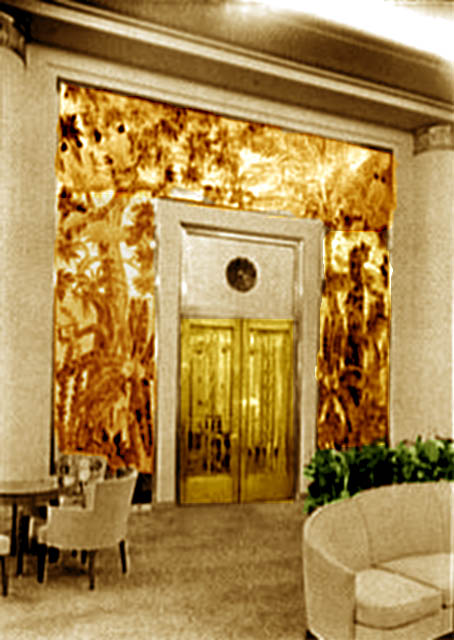
The
Cabin, later the First Class, Main Lounge and her beautiful brass
doors surrounded with a grand mural to say the least!
Colourised
by the author
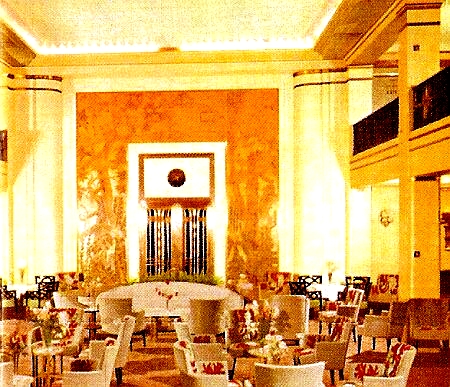 --------
--------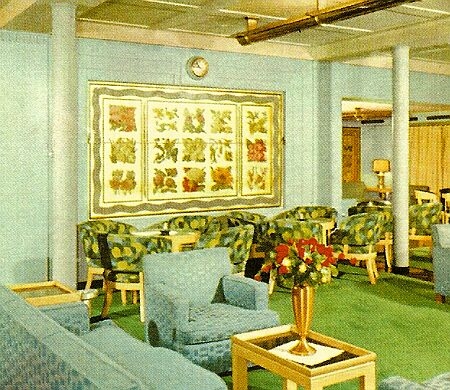
Above
Left: Another look at the forward doors and mural of the
Cabin/First Class Lounge
Above
Right: A delightful lounge with style and glamour, yet in
Tourist, later Cabin Class Lounge
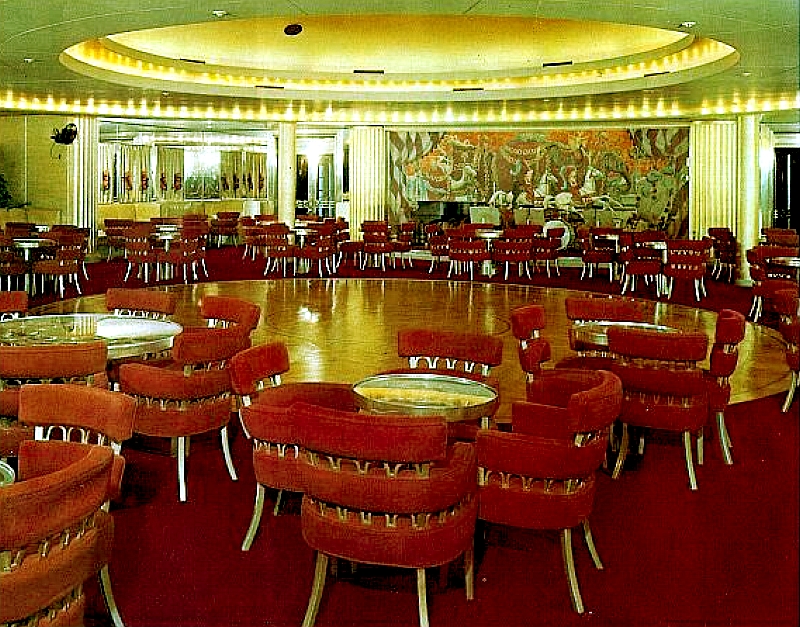
The
wonderful rich gold’s and red of the Cabin/First Class
Ballroom!
Please
Note: There is a separate page with photographs of her
interiors, decks and accommodations!
S.S.
America’s machinery had a weight of some 2,514 tons and
consisted of two sets of Parsons geared steam turbines producing
34,000 SHP driving twin, four bladed screws. And this
has brought me to her specifications, which I will now cover, but
I will do this in far more detail than I do normally as you will
see!
S.S.
America - Comprehensive Specifications from 1940 to 1964:
Names: S.S. America - 1939 to 1941.
U.S.S. West Point - 1941 to 1946.
S.S. America - 1946 to 1964.
Later names: S.S. Australis - 1964 to 1978 Chandris Lines.
S.S. America - June 1978 to August 1978 Venture Cruises.
S.S. Italis - 1978 to 1980 Chandris Group.
S.S. Noga - 1980 to 1984 Intercommerce Corp.
S.S. Alferdoss - 1984 to 1993 Silver Moon Ferries.
S.S. American Star - 1994.
Built
by: Newport
News Shipbuilding & Dry Dock.
Naval Architects: William Francis Gibbs of Gibbs & Cox, New York (NY).
Interior Architects: Eggers & Higgins, NY.
Interior
Design: Smyth, Urquart & Marckwald, NY.
Launched: August
31, 1939.
Delivered: July
2, 1940.
Maiden Voyage: August 10, 1940.
Tonnage: 26,454 Gross Registered Tons (GRT) 1940.
35,440 Full Displacement Tons.
26,314 GRT - 1946.
33,961 GRT - 1960.
Length: 220.4m - 723ft.
Breadth: 28.4m - 3.6ft.
Draught: 8.83m -28ft.
Machinery: Two Parsons steam turbines from builders.
Screws: Two four bladed screws – 126 RPM – 37,400 SHP at normal speed.
Speed: 22 knots service speed, maximum over 24 knots.
Fuel
Consumption: Around
250 tons per day.
Bunker capacity: 4,938 tons.
Cargo Capacity: 323,644 - 1940.
270,964 - 1946.
Watertight bulkheads: 14.
Passenger Decks: 10.
Pubic Venues: 23.
Passengers: 543 Cabin Class, 418 Tourist Class, 241 Third Class - 1940.
516 First Class, 371 Cabin Class, 159 Tourist Class – 1946.
516 First Class, 530, Tourist Class – 1960.
Officers and Crew: 618 - 1940.
785 - 1941 to 1946 USS West Point.
646 - 1946 to 1960.
675 - 1960.
For
interest: Although I have covered her names from 1964 to her end
in 1994, none of this will be covered on this page, except for
the sale details at the end of her career with the United States
Lines! However, there are links to the associate pages that will
continue the story of the lives of this great Liner, as well as
her other pages, including a Photo Page and a comprehensive 1940
Deck Plan, with each deck having a link for enlargements!!
World
War II:
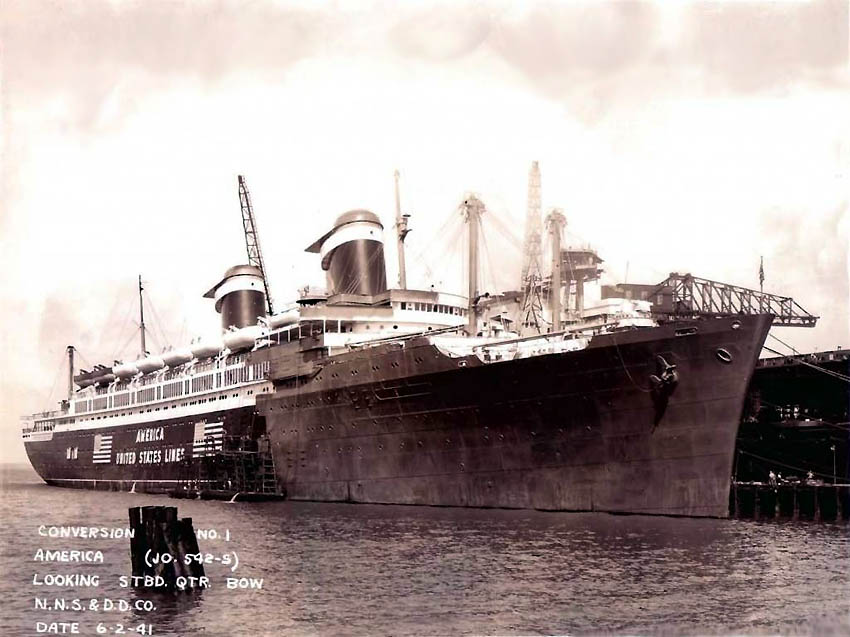
SS
America receives her grey war paint on June 2, 1941, days before
she is officially commissioned for war duties
Photograph
from the U.S. Naval History and Heritage Command - No.
19-N-24561
S.S.
America was officially acquired by the United States Navy, and
she would be converted from a 1,202 passenger liner to
accommodate some 5,400, and later to over 8,000 service men and
women. During the war she would transport well over 300,000
troops safely all over the world, and she also sailed without
escort ships to protect her. Using the ship’s speed and
manoeuvrability, her crew outwitted hostile craft at sea.
On
June 1, 1941, the U.S. Navy, due to nature of the European
conflict, requested that the S.S. America be converted into a
fully operating Troop Transport ship. Just two weeks later, the
Navy officially commissioned her as the U.S.S. West Point
and drafted her into the service of her country. On June 21,
1941, the Secretary of the Navy announced that it was
Captain H.H. Kelley, USN, had been assigned
to West Point as commanding officer.
Strangely
enough, the U.S.S. West Point was known as the Queen of the
transports operated by the Naval Transportation Service, yet some
called her the “monster” as she has a monster of a job
to do. To be very honest, no more than any of the other great
liners used during the war!
Although
she had been stripped of her peace time interior beauty and her
lush lounge and smoking room venues had been altered to
accommodate large numbers, yet she still bore her partial
trappings of her pre-war beauty. It was not uncommon for member
of the crew to find them-selves sleeping in deluxe suites, which
were previously listed at around US$100 per night. In
addition, many of the original murals remained to suggest the
“Wows’” from the soldiers sailing on this great
liner during the war years.
Externally,
a row of life rafts covered her Promenade Deck windows, and
four-tier “standee” bunks were installed just about
everywhere, giving her an initial capacity of 5,400 men and
placements for women. The Smoking Room and Cocktail Lounge became
the officers wardroom and their mess, whilst, amazingly the
Library became the main toilet. The main Lounge was used as a
movie theatre and other uses, whilst the magnificent Ball Room
had bunks for 545 men, the Dining Room became the enlisted
men’s mess and the adjoining foyer was used to wash the mess
kits. Two desalinization units, paravanes, two mast look-out
platforms, and 1,500 tons of ballast were also added.
Refitting
the AP-23 at the Norfolk Navy Yards included the
installation of the following; Four single 5”/38 cal dual
purpose gun mounts. Four single 3”/50 cal dual purpose gun
mounts, four twin 40mm AA gun mounts and eight .50 cal
machine guns. Although the United States was still at
peace, but her largest Liner was armed and ready for anything
they would throw at her!
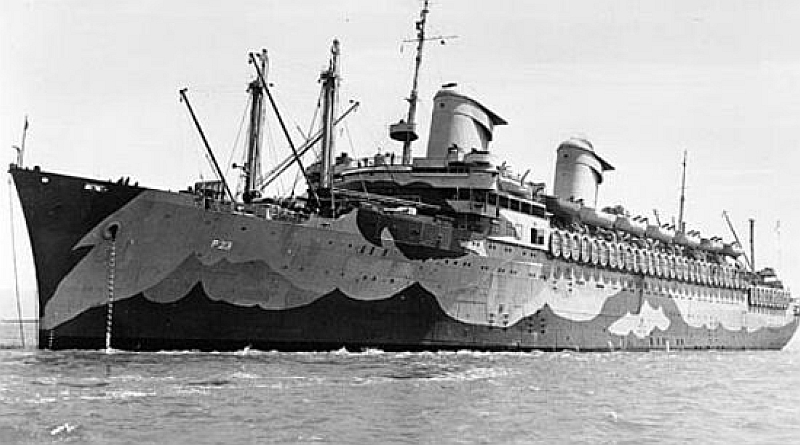
An
excellent view of her war paint – camouflage
Photograph
from the U.S. National Archives, RG-19-LCM - No.
19-N-77620
Having
had a brief shakedown cruise along the Atlantic seaboard,
the U.S.S. West Point began her Navy career during the
“unofficial” phase of the war in the Atlantic. As
a result of President Roosevelt’s closure of all Axis
consulates in June 1941, THE U.S.S. West Point was sent
to Portugal to deliver the ousted Axis diplomatic corps
and in return to bring back to New York our consulates,
dismissed by the Axis.
Her
career almost ended during the, early months of the Pacific War,
when she and the, U.S.S. Wakefield, being the former S.S.
Manhattan, were sent to sail for Singapore early in 1942 to aid
in the evacuation of refugees from the Malayan Peninsula. They
arrived at the very height of Japanese attacks on the beleaguered
city.
For
several days, whilst loading operations were frantically carried
on, her crews watched the enemy bombers very carefully as they
roared over the dock area on their way to Singapore. However
for some strange reason the Japanese pilots seemed to have their
attention diverted from the docked transport ships to other
tasks.
But
suddenly, on the third day, as it was reported, “Lady Luck
deserted us”. Instead of the planes heading toward the city,
they flew over the harbour installations and it was just seconds
before crews and those onboard began to comprehend the complete
helplessness of their situation. A few minutes later the harbour
and dock area were turned into a roaring and fiery inferno. With
bombs bursting within just 50 yards of the U.S.S. West
Point’s hull, WITH Shrapnel being scattered everywhere on
her weather decks, whilst the U.S.S. Wakefield was set
ablaze due to a direct hit. As soon as possible, Captain Kelley
gave the order to sail, and escape the situation and suffer any
further damage.
As
a troopship the U.S.S. West Point also
visited Australia in 1942 to collect Australian
soldiers bound for Singapore. West Point also called
on New Zealand to collect American troops bound
for Noumea.
In
June 1943 Captain Robert A Dyer, USN, became U.S.S.
West Point’s second commanding officer, relieving Captain
Kelley.
Even
after the Singapore close call, the U.S.S. West
Point has a good number of close shaves and escapes! Just
off Rio de Janeiro in 1942, a German submarine sent a
torpedo, which streaked across the U.S.S. West Point’s
bow. Again, in Milne Bay crew members stood at
battle stations for hours against Japanese air raiders, and in
the Red Sea and at Suez she was alerted. With her guns
at the ready and a barrage balloons were lifted against surprise
German torpedo aircraft. In May 1944, Captain Dyer was relieved
as commanding officer by Captain Webb C. Haves, USNR, who
was the grandson of President Rutherford H. Haves.
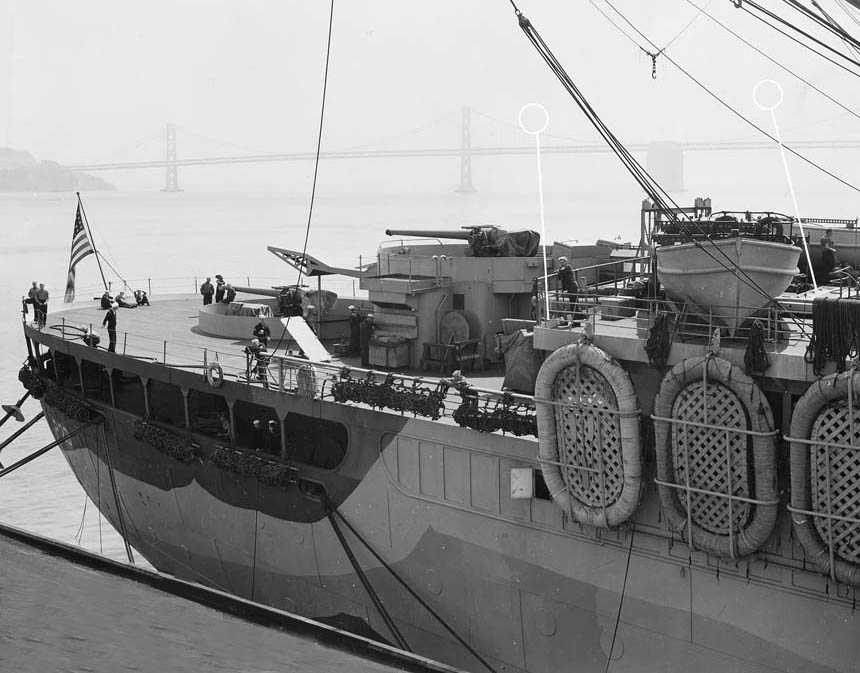
Here
we see her stern and her three gun placements
Photograph
from the U.S. National Archives, RG-19-LCM - No.
19-N-77626
The U.S.S.
West Point also took part in the “Magic Carpet”
Operation. In this role, she made many voyages transferring men
and material from both theatres of operations. Besides
soldiers, U.S.S. West Point has carried sailors amid marines
and other war-time seafarers, allied forces, Red Cross workers,
United Nations officials, and USO, officials, high,
government officials, service nurses, WAC’s and
war brides. But also civilians caught in war zones, prisoners of
war, refugees and children. In addition, there was even a baby
born aboard whilst the ship was the Indian Ocean. This baby
boy was born on February 4, 1942 on the Equator, and he was
christened “Westpoint Leslie Sheldrake,” and the
crew “initiated the juvenile pollywog into a heavenly
shellback, certainly the youngest in the history of the
Navy.”
In
continuous service since the outbreak of the war, the U.S.S.
West Point transported more than 350,000 troops she certainly had
the largest capacity of any Navy Troopship in service during
World War II. On one voyage alone, being in August 1944, she
carried, including ship's company, a grand total of 9,305 people.
And considering she carried over 350,000 troops, being massive
numbers, that is a good share of a grand total of 450,000
soldiers, sailors, and marines that were sent overseas during the
entire war!
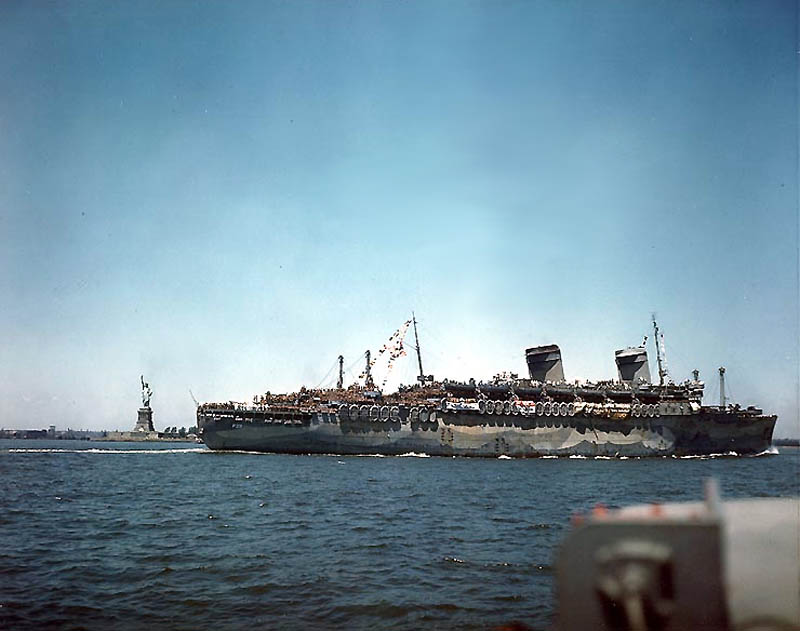
Above
& Below: Two dramatic images when the U.S.S. West
Point (AP-23) arrived home
In New
York on July 11, 1945 with a some 7,607 veterans on
board
Photograph
from the US National Archives - No 80-G-K-5783-A
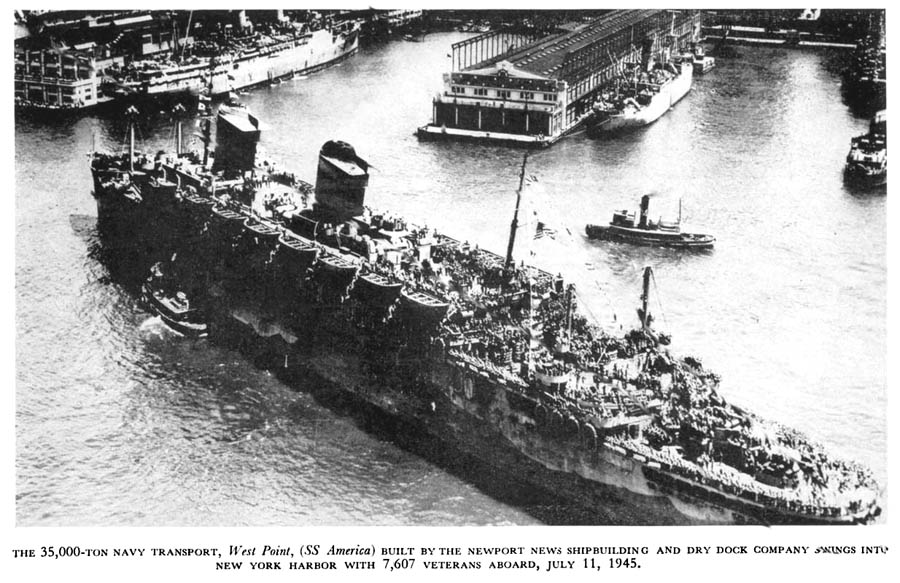
The U.S.S.
West Point also covered more than 436,144 miles, being equal to
16 voyages around the globe. The ship has made as many as 24
crossings of the Atlantic in a single year. Her ports
include Bombay, Marseilles, Cape Town,
Guadalcanal, Naples, Liverpool, Noumea, and Mers’el’Kebir.
She had saw and stood up to many emergencies, having been a
hospital evacuation ship as well as a prison ship.
The U.S.S.
West Point was reassigned to the Pacific on December 5, 1945, and
she sailed departed Boston on December 10, for Manila
sailing via Pearl Harbour. She had some 7,757 persons
aboard, including the last 247 enlisted WACS in the
Pacific.
Having
arrived in Manila, she departed again on January 15, 1946,
and she arrived home in New York City and
docked at Pier 88 on February 7, 1945, and this turned out to
be a voyage that ended her time in the U.S. Navy! For a directive
had come in, dated February 1946, that the U.S.S. West Point
(AP 23) was to be transferred to the War Shipping Administration
preliminary to be her returned to the “United States
Lines” for private duties on the North Atlantic service.
For
the most part, her wartime voyages were made without the
protection of convoy warships. Her main defence was her great
speed, which has never been officially released, but it was well
over 25 knots! In addition, she was the amazing war-time ship
that survived in astonishing circumstances, never once broke
down, and she had not lost a single passenger!
From
Pier 88 she proceeded to Portsmouth, Virginia, arriving
on the February 11, and she was released from duty on the
February 22. Her final voyage under the name of West
Point was a rather short one, just seventeen miles to her
birthplace, being Newport News Shipyards, where she was
officially decommissioned on February 28, and then officially
stricken from the Navy Register on March 12, 1945.
S.S.
America finally commences her Atlantic services:
On
December 4, 1946, the now decommissioned as flagship of the
United States Lines, received her final tribute from the U.S.
Navy as the S.S. America became the first merchant vessel to
receive a Warrant to fly the “Naval Reserve Pennant.”
In a ceremony on the bridge of the S.S. America, Admiral Thomas
Kinkaid, USN, the then Commander of the Eastern Sea
Frontier, presented the flag to Commodore Harry Manning, the S.S.
America’s Captain.
To
restore the ship to her original role was going to be an
expensive business, and sadly, in 1941 in their haste to prepare
her for the navy, many of her valuable fittings had been
discarded, and some of her original pieces of art as well as some
precious brass works had been lost. Due to the naval alteration,
her accommodation numbers were also lowered and now instead of a
total of 1,202 now it would be just 1,046 maximum in her three
classes, which was now designated as, First Class, Cabin Class
and Tourist Class.
The
S.S. America returned to New York from
the Newport yards on November 11, 1946, and she would
be quickly made ready for her very first commercial Atlantic
crossing!
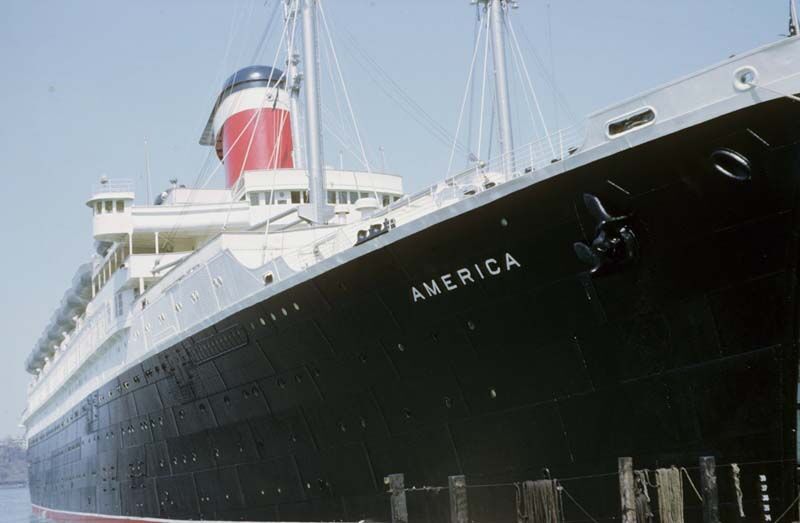
The
S.S. America looks smart fully repainted and ready to become a
Trans Atlantic Liner!
The
photographer is unknown to the author. Please see the photo notes
at the bottom of the page
Amazingly,
the gleaming S.S. America and the new British Liner the R.M.S.
Queen Elizabeth arrived in New York at much the same time, for
both ships had been affected by the war and would commence their
commercial duties just now. Both ships were welcomed by a
large flotilla of craft, in addition the Navy, put on a display
of escort destroyers, as well as a blimp and had some 30 aircraft
in the air welcoming the ex US.S. West Point/America
to New York, as well as the great Queen which has also
served her country bravely during the war! Around 1,000 people or
more watched The S.S. America berth at pier 61 and it was a
tricky manoeuvre due to strong tides and winds. However, with the
assistance of six tugs the America finally docked at
10:40 AM.
Just
prior her departure on November 14, 1946, the S.S. America was
honoured by a most gracious visit by the Presidents daughter,
Margaret Truman. Then at 4.00 PM sharp the S.S. America sailed
bound for Cobh Ireland,
Southampton England and Le Havre France.
For
the S.S. America this was much more than just commencing her
commercial voyage, for this voyage was the start of the
fulfilment of what she was designed to do, and now finally so
long after her maiden voyage she had finally become the
“Trans-Atlantic Liner” she was meant to be!
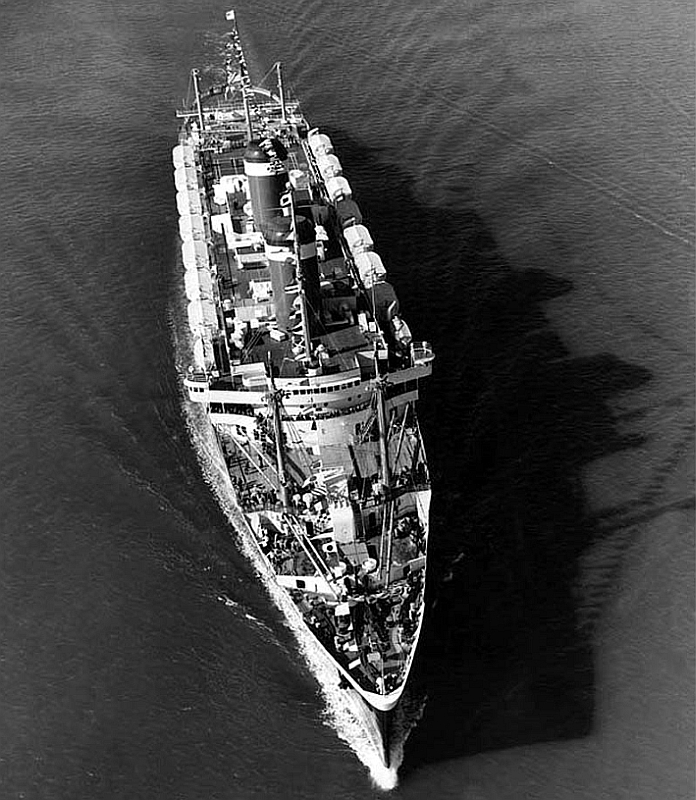
A
wonderful aerial photograph of the S.S. America
Note
the Third Class Promenade Deck, located on Upper Deck, directly
forward of the superstructure
Directly
below, two decks down on A Deck are the Third Class Main Lounge
and Smoking Room
Obviously,
her first winter voyages forced all what the North
Atlantic weather could possibly throw at her, all that was
bad, as well as the good! But S.S. America continued to ply her
trade faithfully for the next eight years.
But
it need to be said that the S.S. America was the Unites States
largest Liner, as well as being the country’s “Ship of
State,” thus she was in many ways a showcase for the very
best in American engineering, as well as art, craftsmanship,
superior interior design and of course the very best in fine
cuisine. Being an all American product, she featured Oregon pine
decking as well as Rhode Island silverware on the
dining room tables. Wherever you looked, a piece
of America would be there to showcase the country!
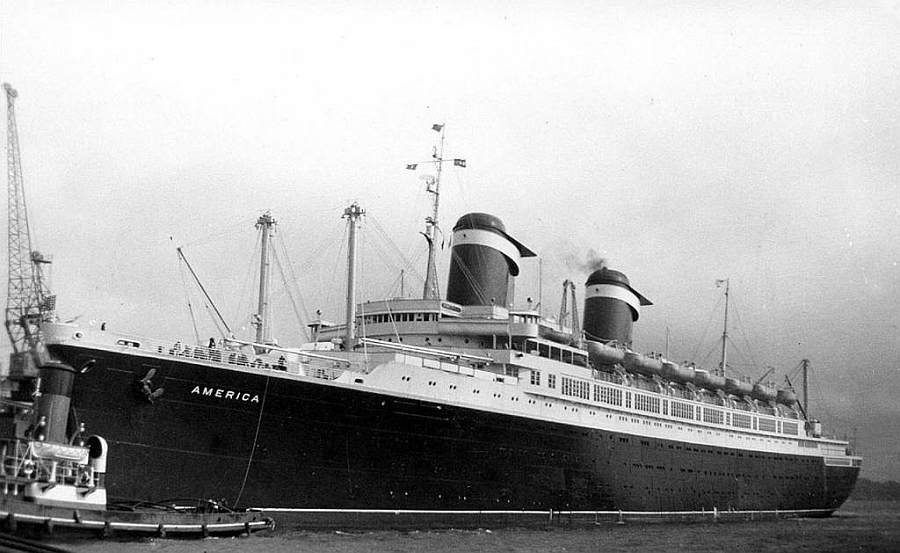
The
S.S. America is seen at Southampton
All
the aforementioned came together to create a truly First Class
experience that would attract not just the Tourists, but also
Diplomats, Royalty and the countless Hollywood stars and world
famous Recording stars alike! She very soon proved to be a
success, as her Cabin Class was simply the very best, whilst her
Tourist Class was more like most other company’s First
Classes, and Third Class was indeed most comfortable with three
fine Lounges and a spacious Dining Room!
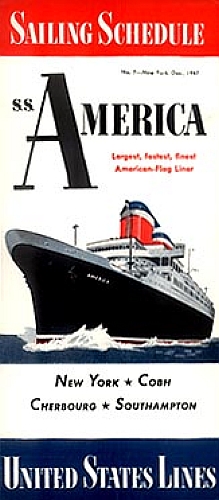
S.S.
America “Sailing Schedule” from December 1947 to
December 1948
Provided
by Björn Larsson www.timetableimages.com/maritime/images/list.htm#O
United
States lines are famous for their excellent maintenance programs,
and the S.S. America was taken back to Newport-News-Yards early
in 1950 for a good hull maintenance check, thus she was placed
into dry-dock and had some additional interior work undertaken.
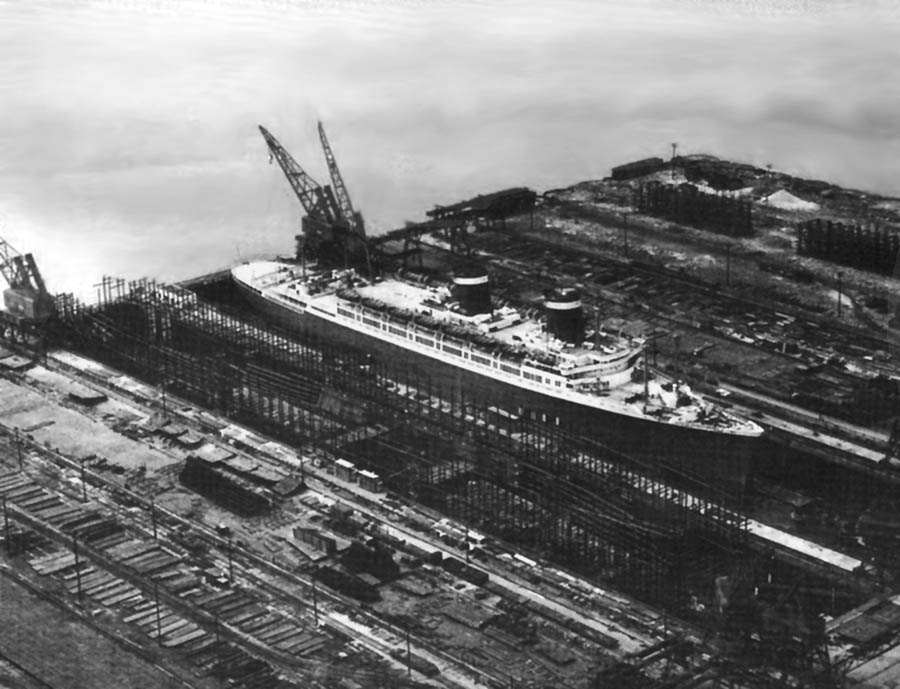
What
is so very special about this photograph? Yes we can see the SS
America at the Newport-News-Yard on April 2, 1950
But
there is something more! Right next to her, on her starboard side
you can see the skeleton of what will be the greatest American
Liner ever to be built, the S.S. United States, winner of both
the East & West bound “Blue Riband” and holds it
still!
As
her over all popularity increased on October 25, 1951 her service
had been extended to Bremerhaven Germany where she
would berth at the Columbus Pier.
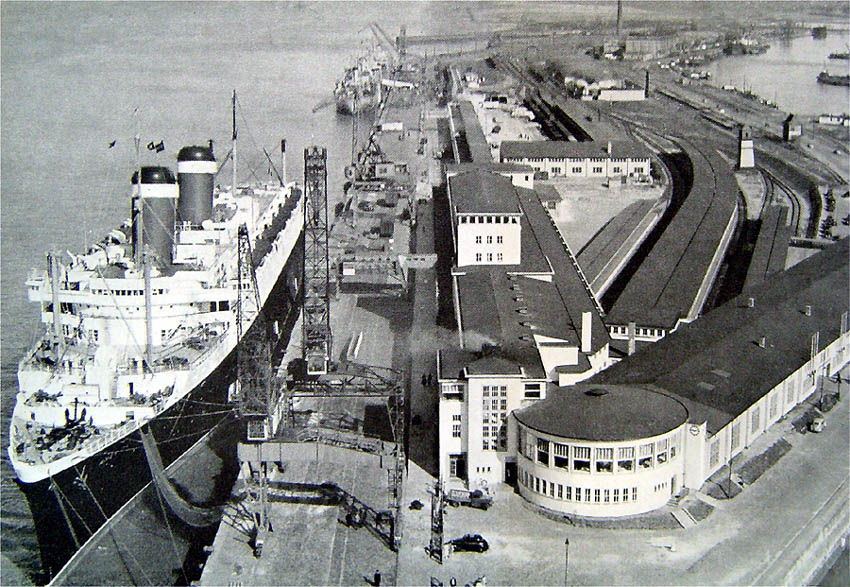
SS
America is seen berthed at the Columbus Pier
at Bremerhaven around 1954
The
photographer is unknown to the author. Please see the photo notes
at the bottom of the page
Her
early voyages faced all that the North Atlantic weather
could possibly throw at her, all that was bad, and the good! But
the S.S. America continued to ply her trade faithfully for the
next eight years.
During
her next maintenance and refit at the Newport-News-Yards, she
received in 1960, her accommodations were altered with some
upgrades done and she finally became a Two Class Liner! She
accommodated the same number of passengers, a total of 1,046, but
it would be 516 in First Class and 530 in Tourist Class, with the
ex Third Class Lounge, Smoking Room and Dining Room being used
for other purposes. Upon completion she was registered at
33,961 GRT.
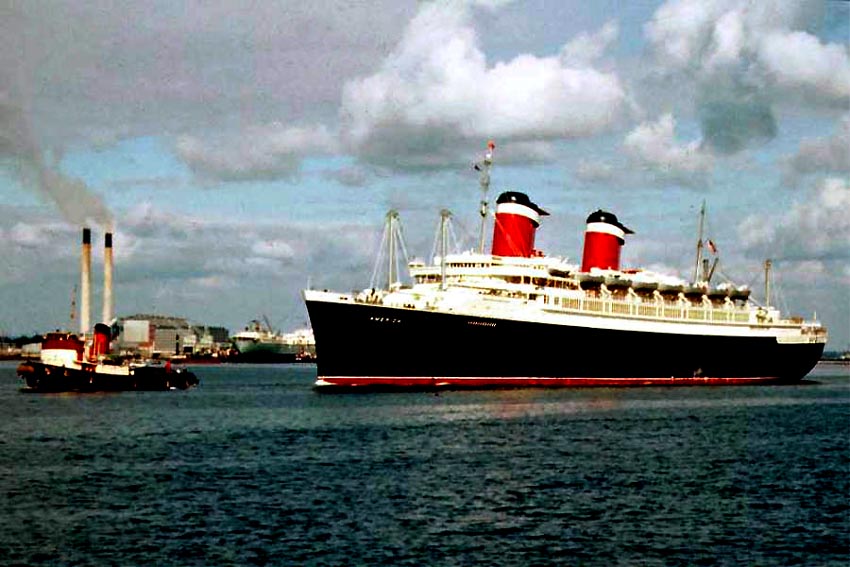
An
all new Two Class Liner appears for duties!
The
photographer is unknown to the author. Please see the photo notes
at the bottom of the page
Even
though the United States lines had attempted to draw
more passengers to the ship with the ships improvements, changing
her to a Two Class configuration and having commenced a major
advertising campaign, but sadly due to a number of factors she
began to loose her loyal customer base. Thus like with all
shipping companies worldwide, as airline's were offering new air
services in competition and even now operating cheap charter
flight, the passenger shipping industry fell victim to this, as
well as being financially wounded by the ongoing union
interference, which resulted in cancelled sailings, and there is
nothing worse for any company and that is loosing the trust of
their passengers. But, unions just do not care for their aim is
to get what they want, or they will destroy!
S.S.
America’s final American days:
Sadly,
after 24 years of exemplary service, her long career under the
United States flag was about to come to an end, which was due to
two factors; 1. Air travel having become more and more
popular, and 2. Thanks to the never ending labour disputes
that was destroying passenger shipping on both sides of
the Atlantic. Unions are mostly run by Irish and
British migrants (even here in Australia) and they were
responsible for so much of the decline of passenger shipping
worldwide and yet, they continue to destroy and even these days
run cargo shipping into the ground!
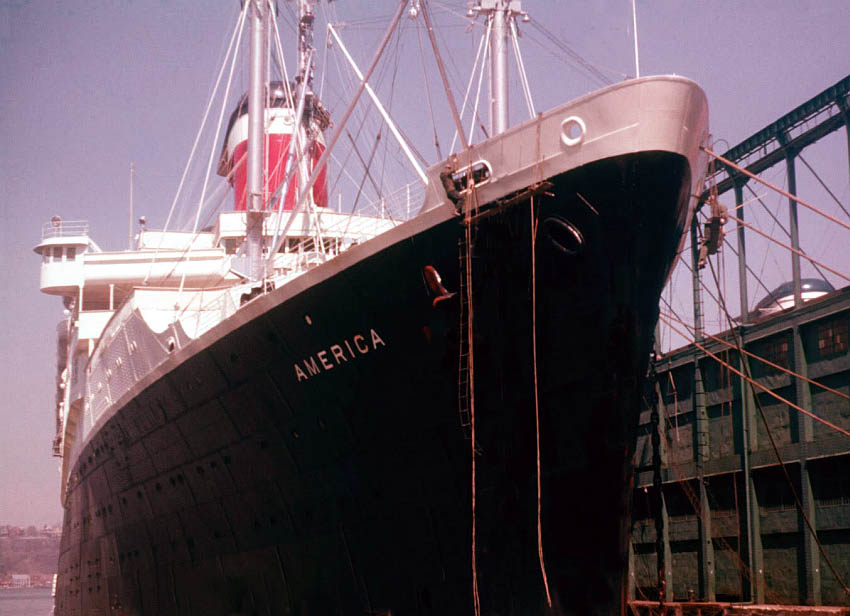
S.S.
America berthed in New York with the S.S. United States
seen on the other side
Thus,
with the great and wonderful ship that was
once America’s largest liner the S.S. America could no
longer continue as she was costing the company far too much. And
yes, her newer sister had taken her glory. Even though William
Francis Gibbs used America’s basic design in principle
based for the S.S. United States, but a larger version and there
would be the use of a great deal more of aluminium as this ship
was to be fireproof! But, that would never become a great and
proud warrior, like her smaller sister! Yes, there ius no
doubt that the S.S. United States would be the world’s
fastest ship, and become the proud holder, and is so today of
the “Blue Riband” for both the East
and Westbound voyages between New York and the UK, an honour she
never lost, However, in reality that is her only badge of
greatness!
Recalling
the Great Days of a Great Ship:
1.
Naval Career:
It
has been well recorded that the S.S. America served during WW2
and achieved greatness being a rare ship during that dangerous
time never to have broken down, and for the most part her
voyages were extremely dangerous, as she sailed without any
accompanying of convoy warships, thus she did not have any
protection, except her own guns onboard! It was said that her
main defence was her great speed, and her official speed has
never really been officially released, but we do know that it was
more than what we have been told it being of around 25 knots!
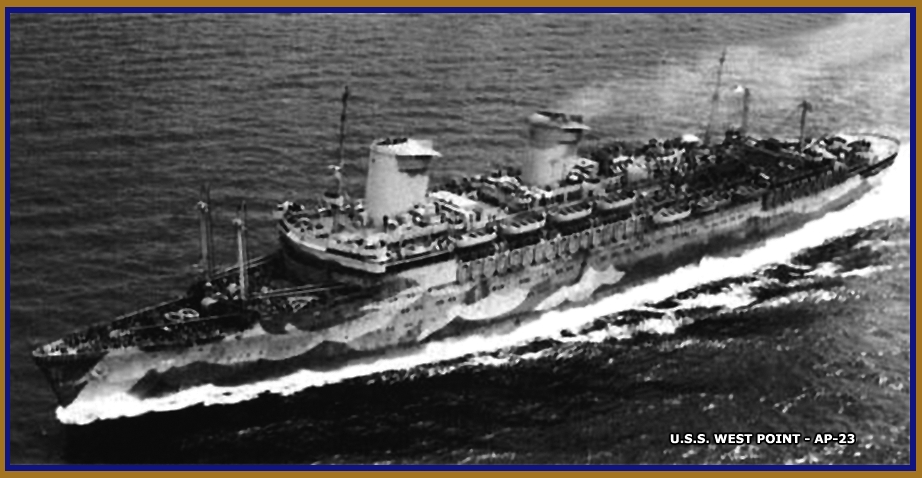
The U.S.S.
West point seen at full speed ahead at sea
She
survived being bombed in Singapore in 1942, and was in
many very dangerous situations, thus it is amazing how this great
war-time ship actually survived in the most astonishing
circumstances, and also she never lost a single soul!
Considering
that she as the U.S.S. West Point she carried well over
350,000 troops, being huge numbers and that she also covered more
than 436,144 miles, being equal to 16 complete voyages around the
globe. The S.S. America has a record of greatness both in
wartime, but she was also one of the finest liners, as she
offered the very best of American style and comfort across
the Atlantic! She did indeed offer a great alternative to
the opposition in Britain and the European’s!
2.
Commercial Career:
There
is no doubt that the S.S. America had a smooth and a trouble free
career that would be until September 1963, when the union
commenced their strikes and industrial action and that hit the
ship very hard. Amazingly, she even came under a racial
discrimination claim from some her workers, and for that reason,
this great ship was tragically forced into complete layup.
This was a disgraceful union beat-up that forced her into an
extended five month layup, in fact until February 7, 1964,
when she finally was to depart for Southampton and
again operate her regular duties as well as some cruises.
However
as she was about to depart, Captain Fender was advised that there
was some industrial action going on within the Tug’s, but
not related to the ship in any way, but there were no tug working
at all. Thus the Captain decided that he would not be delayed one
single minute and that he would to take his ship out without any
assistance, as there were no tugs, even though there were strong
winds blowing that day! The great S.S. America slowly moved from
her pier and departed from New Yourk completely unaided
and she was on her way on time!
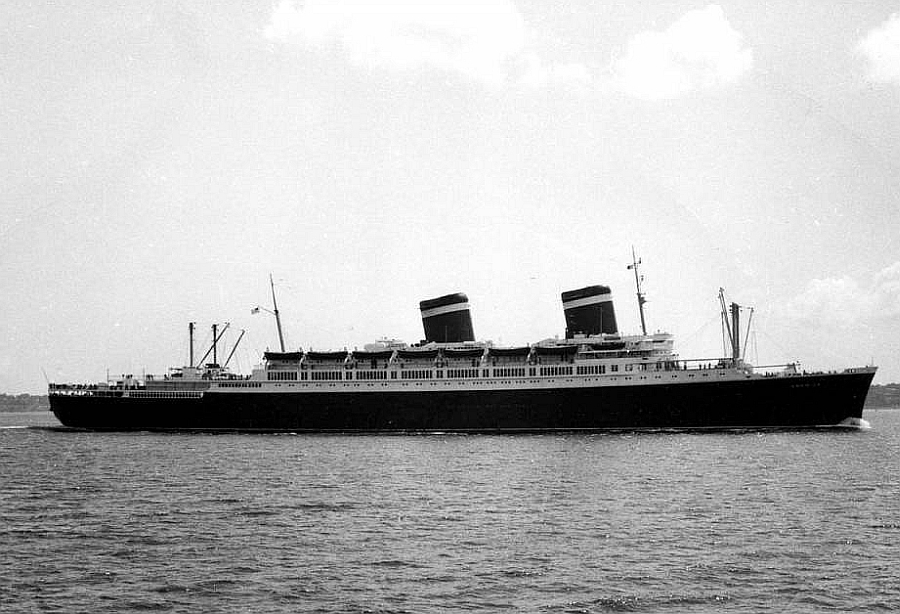
A
fine starboard view of the S.S. America
The
photographer is unknown to the author. Please see the photo notes
at the bottom of the page
The
End for the S.S. America is near:
Sadly
the United States Lines was running into difficulties
financially, and it would appear that plans had been made for
S.S. America’s voyage on October 27, 1964 to be her very
last with the company.
It
would be without any ceremony whatsoever, as there had not been
any public announcements, the proud S.S. America slowly and
proudly left Pier 86 on October 9, 1964 having just 439
passengers aboard.
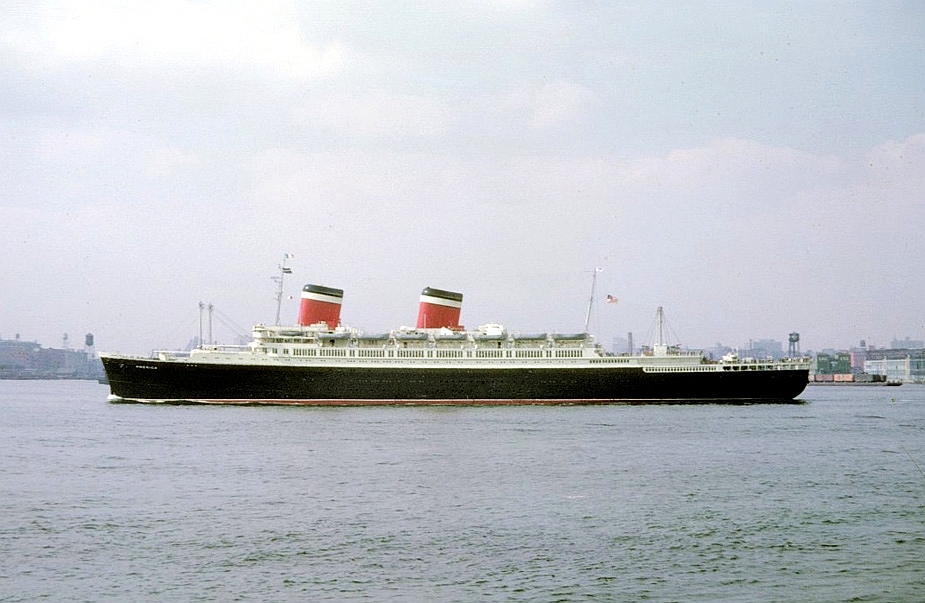
The America’s
last departure from New York bound for the United
Kingdom and back
On
October 9, she departed for her very last return Trans Atlantic
voyage ever!
She
returned to New York from Southampton on
October 27 at 8:00 AM, with 801 passengers aboard. There was a
prevailing gloom amongst the crew, and when passengers aboard
found out that this was her very last voyage, they could not
believe that it had not been announced, for everyone believe that
the ship would have been packed, as so many would have loved to
sat a final farewell!
She
arrived home to New York on October 27, and 2with her
passengers having disembarked her then 457 crew were
discharged. She departed New York for the last time
under an United States flag at 6:00 PM as she
headed for her birthplace Newport-News Shipbuilding Yards, where
she awaited her fate.
On
November 4, 1964 the United States Lines officially requested
permission from the Maritime Administration to sell the S.S.
America to “Okeania S.A.,” being a subsidiary of
Chandris Lines, for use as passenger and emigrant vessel. U.S.
Lines cited “substantial net losses for several years”
and that “no prospects exist for years improving such
results.”
Considering
the company was losing as much as US$1.5 million per
year, even whilst receiving US$3 million in subsidies.
But keeping all things in mind, the Maritime Administration
approval came the very next day, when it was announced that there
was a sale for US$6.5 million, complete with the
understanding she not compete with any of the U.S. flag liners
from American ports for at least five years and if necessary,
would be made available for war emergency use and be either under
the U.S. flag, that of Greece as part of NATO!
S.S. America goes
to Chandris Lines on November 16, 1964:
The
S.S. America was handed over to the author’s dear friend
Anthony Chandris, of “Okeania S.A.” or
“Chandris Lines” on November 16, 1964, and with the
Red, White and Blue on her funnels having disappeared under a
coat of Chandris blue and a black top. Then on November 18, she
was renamed “Australis” and flying the Greek flag, and
the ex S.S. America departed and headed for Malta where she would
enter into dry-dock to become a much loved liner in Europe,
Britain as well as in New Zealand and in Australia, the
S.S. Australis was a much loved ship, for she had a
great heritage!
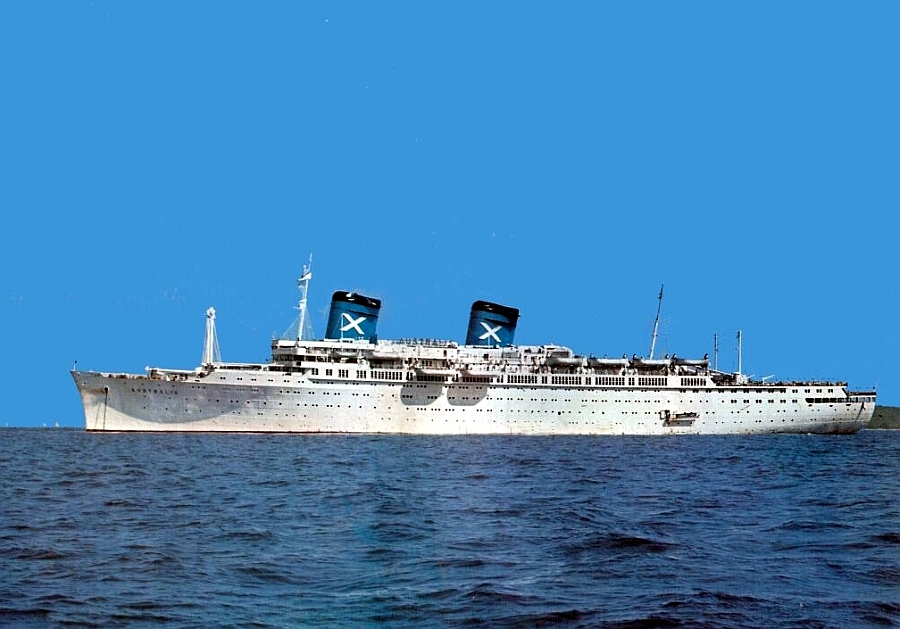
Even
all white the ex S.S. America looked beautiful as the
S.S. Australis!
During
her commercial service the S.S. America made some commercial 288
voyages having accommodated a remarkable 476,462 passengers. Each
year she made between 15 to 18 round voyages, and personally
having sailed on her a good number of times, I believe that she
was the perfect ship as far as her size is concerned, and her
internal beauty, sheer comfort, and her having that great speed!
Also, she was a ship that never had any real problems of any kind
and that made her the PERFECT LINER!
Farewell
to the Wonderful S.S. America as she Heads for New
Water’s
But
leaving us with so Many Great Memories!
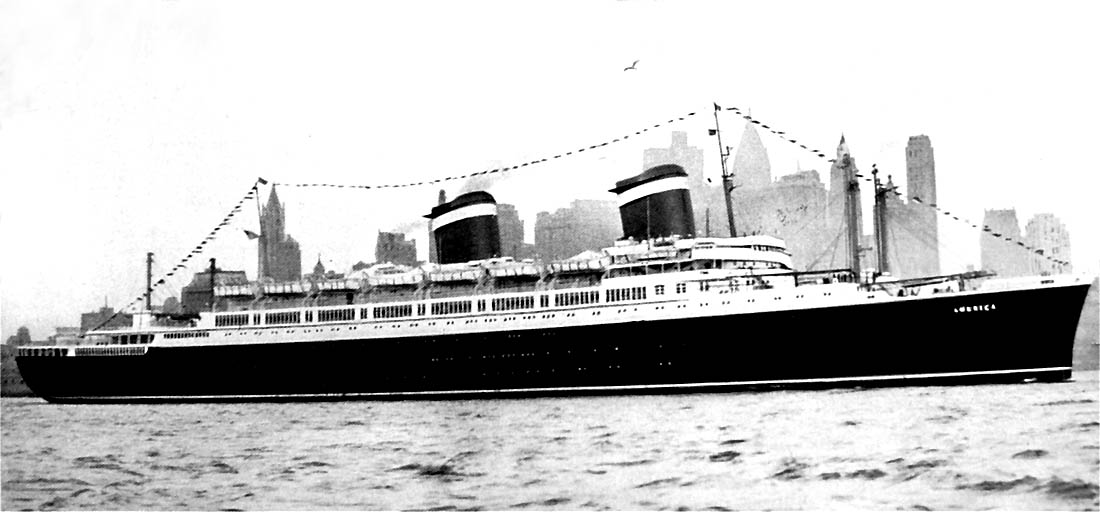
This
photograph was of her second maiden voyage, her very first
commercial Trans-Atlantic crossing
from New
York on November 14, 1946 to Cobh Ireland,
Southampton England and Le Havre France
S.S.
America INDEX:
Page
One … S.S.
America History Page.
Page Two … Photo
Page.
Page
Three … 1940 Deck Plans.
S.S. Australis INDEX:
Page
Four … S.S. Australis History
Page from 1964 to her tragic end in 1993.
Page
Five … Brochure
& Photo & Page One.
Page
Six … Brochure
& Photo Page Two.
Page
Seven … Deck Plans.
Other Chandris Ships INDEX:
SS Ellinis … Ex
Matson Lines liner SS Lurline.
SS Patris … Ex Union Castle Lines RMS Bloemfontein Castle.
SS Britanis … Ex
Matson Lines SS Monterey, but renamed Lurline & Matsonia.
***********************************
Return
to the ssMaritime
MAIN INDEX
Please
Note: ssmaritime and associated sites are 100% non-commercial
and the author seeks no funding or favours of any shape
or form, never have and never will!
Photographs on
ssmaritime and associate pages are by the author or from
the author’s private collection. In addition there are some
images that have been provided by Shipping Companies and private
photographers or collectors. Credit is given to all contributors.
However, there are some photographs provided to me without
details regarding the photographer/owner concerned. I hereby
invite if owners of these images would be so kind to make
them-selves known to me (my email address may be
found on www.ssmaritime.com only), in order that
due credit may be given.
This
notice covers all pages, although, and I have done my best to
ensure that all photographs are duly credited and that this
notice is displaced on each page, that is, when a page is
updated!
ssMaritime is
owned & © Copyright by Reuben Goossens - All Rights Reserved